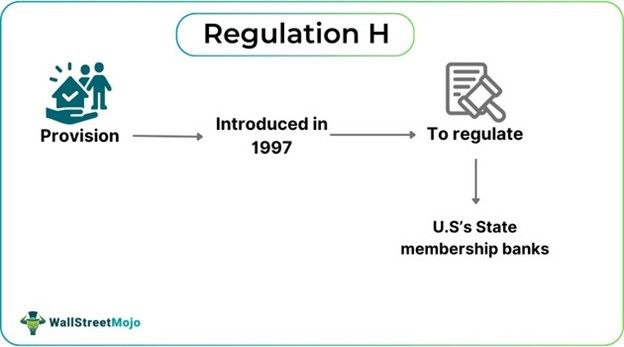Table of Contents
What Is Regulation H?
Regulation H is an instrument to implement provisions of the Federal Reserve Act introduced to impact state member banks. It aims to reduce regulatory burdens imposed on well-run banks and focus the supervisory processes on risks associated with the banks in the U.S.

The regulation introduced a new terminology into the provisions termed as the eligible bank. This would segregate banks for expedited membership treatments and branch applications. In essence, they provide guidelines on privileges and what state-chartered banks need to maintain membership. It states the procedures that are to be followed by the banks that are not adequately capitalized.
Key Takeaways
- Regulation H is a provision in the U.S. that deals with the state banking institutions' membership in the Federal Reserve System.
- The regulation provides guidelines for eligibility of members, application of stock conditions and the conditions to be followed for achieving membership.
- The provisions focus on the safety and soundness of the banking practices, prohibition of changes in business character in the future and adherence to the Bank Secrecy Act.
- It is important as it regulates the banks, their lending activities and combating financial crimes through reporting of suspicious activities.
- These measures help ensure the financial stability of the system.
Regulation H Explained
Regulation H banking provision talks about the membership of state banking institutions in the U.S. Federal Reserve System. It governs the state member banks and those willing to apply for membership in the Federal Reserve System. The system is responsible for the formulation of monetary policies, ensuring financial system stability, financial institution safety etc. They are made of 12 federal reserve banks of major cities in the U.S and the board of governors (Washington D.C.). The system membership is dealt with as per provisions of section 9 of the Federal Reserve Act.
Subpart A of the regulation deals with the requirements for eligibility requirements for state-chartered banking institutions' membership in the system. It has provisions regarding the conditions that are imposed on the members, the dividend and capital requirements, including those needed to establish and maintain branches.
It also deals with the applications for membership and stock; the banks are required to submit stock applications along with the membership request. The regulation contains provisions for expedited approval for eligible banks along with the bank holding companies. The rules demand member banks to operate by maintaining safety and soundness. They shall not change business characters or corporate powers without complying with the provisions as set under the regulation.
Requirements
Subpart F of the Regulation H Bank Protection Act contains miscellaneous requirements under sections 208.60-208.64)
It requires the bank to implement security procedures in order to
- Discourage crimes of a certain nature.
- File observed reports of suspicious activity.
- It requires members to comply with the Bank Secrecy Act's requirements for record-keeping and reporting foreign as well as currency transactions.
Generally speaking, the provision requires adherence to capital requirements, securities activities, and crime prevention activities. It also requires banks to comply with written policies to comply with the banking standard practices. Etc. These requirements are also subject to changes by the new update of the law.
Importance
The following are some of the points that highlight the importance of the regulation h Bank Protection Act:
- The regulation has provisions that govern the deposit and lending activities of banks admitted as members. These lay down control over excess activities.
- It ensures equitable distribution of banking services through the prohibition of interstate branches from fundamentally serving as deposit collection centers.
- It promotes and enhances community banking.
- It ensures building integrity and maintaining the transparency of financial markets through the involvement of bank activities in securities and stock-related activities.
- The regulation requires reporting of suspicious activities and reports invalidated foreign transactions. This helps in combating financial crimes such as money laundering.
- It provides guidance for branching and, through this, helps banks achieve stable growth and, in turn, helps in the stability of the system.
- It helps banks reduce losses by establishing capital adequacy provisions, preventing a system failure.
- It helps in risk mitigation.
- It helps banks comply with the rules of the land.
- All of the above activities help maintain an economy's financial stability.
Regulation H vs. Regulation G
Given below are some of the differences between both concepts:
- Regulation H banking provision deals with state membership of banks.
Regulation G deals with the general rules that pertain to non-GAAP financial measure disclosures.
- Regulation H provides provisions that facilitate the equitable distribution of banking services in a community. Regulation G, on the other hand, focuses on reducing discriminatory lending practices.
- Regulation H mandates suspicious activity reporting based on the Banking Secrecy Act. Regulation G has provisions that mandate reporting agreements that are related to the Federal Community Reinvestment Act and disclosures.
- Regulation H was introduced in 1997. Regulation G was introduced in 2003.
